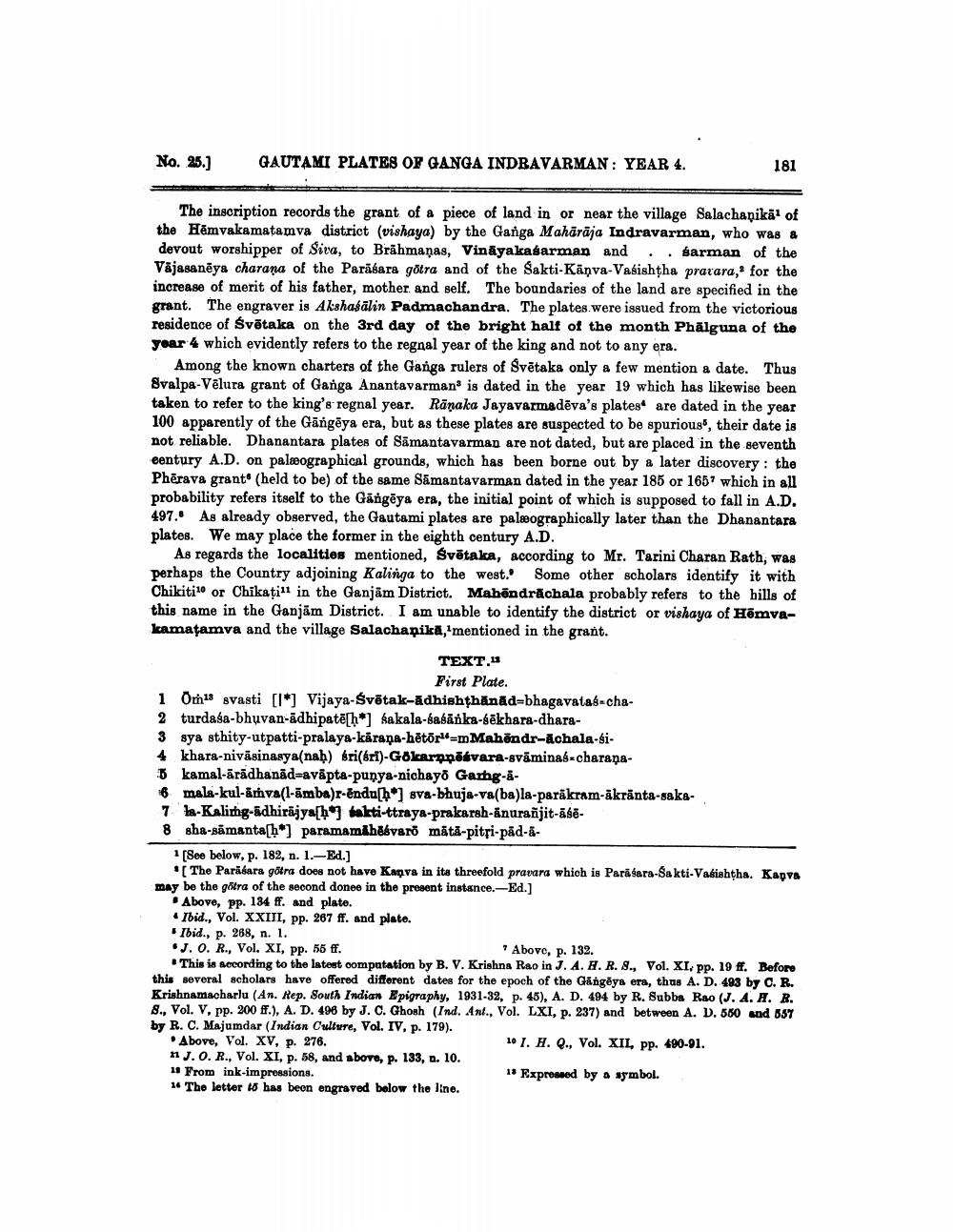________________
No. 25.]
GAUTAMI PLATES OF GANGA INDBAVARMAN : YEAR 4.
181
The inscription records the grant of a piece of land in or near the village Salachanikäl of the Hemvakamatamva district (vishaya) by the Ganga Mahārāja Indravarman, who was & devout worshipper of Siva, to Brāhmaṇas, Vināyakasarman and ..barman of the Vajasaněya charana of the Parāśara götra and of the Sakti-Kāņva-Vaśishtha prarara, for the increase of merit of his father, mother and self. The boundaries of the land are specified in the grant. The engraver is Akshasălin Padmachandra. The plates were issued from the victorious residence of Svētaka on the 3rd day of the bright half of the month Phälguna of the yoar 4 which evidently refers to the regnal year of the king and not to any era.
Among the known charters of the Ganga rulers of Svētaka only a few mention a date. Thus Svalpa-Vēlura grant of Ganga Anantavarman is dated in the year 19 which has likewise been taken to refer to the king's regnal year. Rānaka Jayavarmadēva's platese are dated in the year 100 apparently of the Gāngęya era, but as these plates are suspected to be spurious, their date is not reliable. Dhanantara plates of Samantavarman are not dated, but are placed in the seventh eentury A.D. on palæographical grounds, which has been borne out by a later discovery: the Phērava grant (held to be) of the same Samantavarman dated in the year 185 or 1657 which in all probability refers itself to the Gängēya era, the initial point of which is supposed to fall in A.D. 497. As already observed, the Gautami plates are palæographically later than the Dhanantara plates. We may place the former in the eighth century A.D.
As regards the localities mentioned, Svētaka, according to Mr. Tarini Charan Rath, was perhaps the Country adjoining Kalinga to the west. Some other scholars identify it with Chikitio or Chikați" in the Ganjam District. Mahāndrāchala probably refers to the hills of this name in the Ganjam District. I am unable to identify the district or vishaya of Hēmvakamatamva and the village Salachapika,"mentioned in the grant.
TEXT.
First Plate. 1 Oras svasti [l*] Vijaya-śvētak-adhishthānād=bhagavatas-cha2 turdasa-bhuvan-adhipatē[h*) kakala-babanka bēkhara-dhara3 sya sthity-utpatti-pralaya-karana-hőtör"=mMahöndr-Achala-si4 khara-niväsinanya(nah) sri(Gri)-Gokarpnisvara-sväminas-charaņaB kamal-ārādhanād=avāpta-punya-nichayo Garg-&6 mala-kul-amva(l-ambar-endu[b ] sva-bhuja-va(ba)la-parakram-ākrānta-saka7 la-Kalimg-ādhirajya[by takti-ttraya-prakarsh-anurañjit-ase8 sha-samanta[bo] paramamihăsvarð māti-pitsi-pad
[See below, p. 182, n. 1.-Ed.]
[The Parāśara götra does not have Kanva in its threefold pravara which is Parāśara-Sakti-Vabishtha. Kapva may be the götra of the second donee in the present instance.-Ed.]
. Above, pp. 184 ff. and plate. • Ibid., Vol. XXIII, pp. 267 ff. and plate.
Ibid., p. 268, n. 1. .J. 0. R., Vol. XI, pp. 55 ff.
* Above, p. 132. • This is according to the latest computation by B. V. Krishna Rao in J. A. H. R. 8., Vol. XI. pp. 19 ff. Before this several scholars have offered different dates for the epoch of the Gangěys era, thus A. D. 483 by C. R. Krishnamacharlu (An. Rep. South Indian Epigraphy, 1931-32, p. 45), A. D. 494 by R. Subba Rao (J. A. A. R. 8., Vol. V, pp. 200 ff.), A. D. 498 by J. C. Ghosh (Ind. Ant., Vol. LXI, p. 237) and between A. D. 560 and 857 by R. C. Majumdar (Indian Culture, Vol. IV. p. 179). . Above, Vol. XV, p. 276.
10 1. H. Q., Vol. XIL, PP. 490-91. J.O. R., Vol. XI, p. 58, and above, p. 133, n. 10. 11 From ink-impressions.
1* Expressed by a symbol. 16 The letter 18 has beon engraved below the line.




